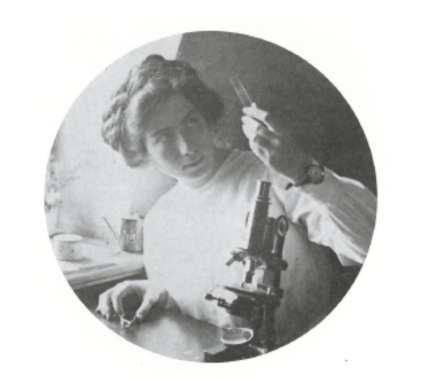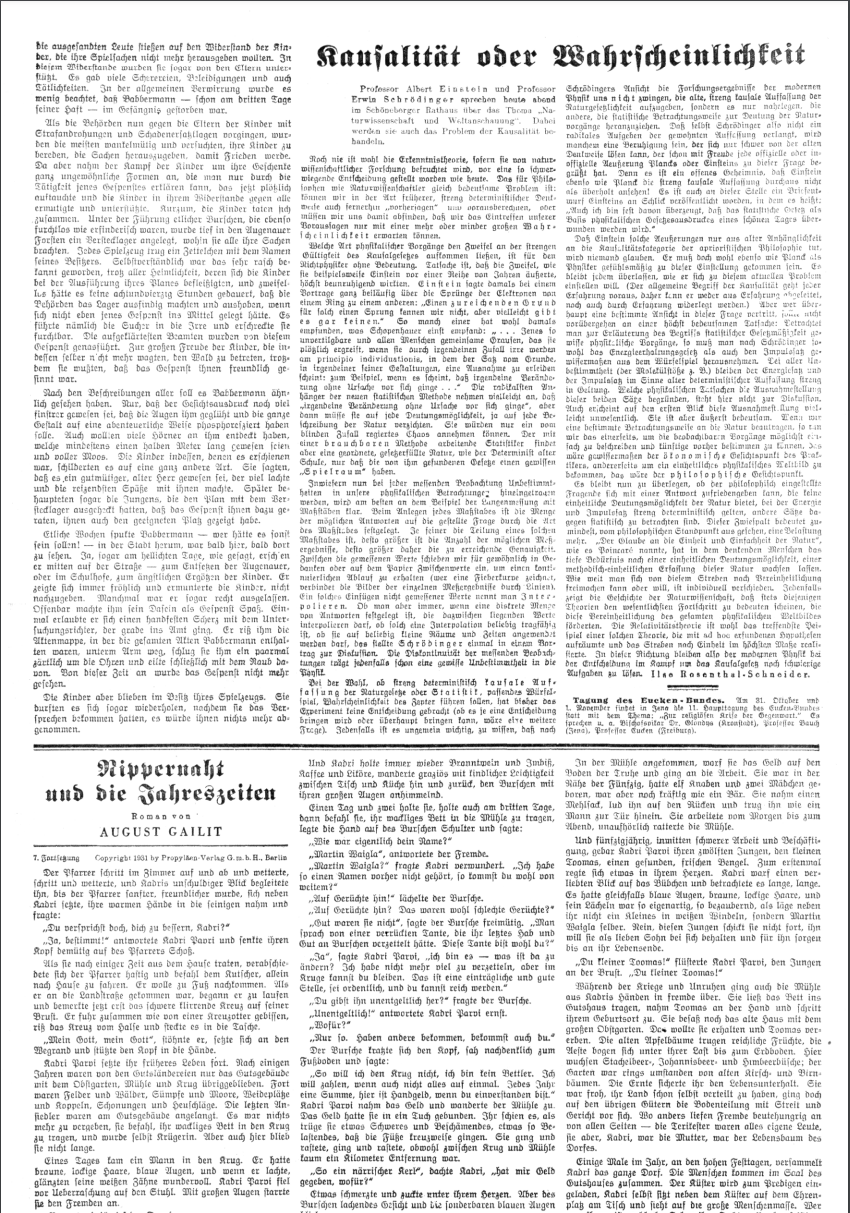Ilse Rosenthal-Schneider (1891–1990): Building Bridges between Philosophy and Sciences Across Continents
Our project on Ilse Rosenthal-Schneider (1891–1990) aims to build bridges across academic disciplines and continents and to integrate history and philosophy of science. The project includes an international cooperation with our cooperation partners Daniela K. Helbig and Maureen A. O’Malley, School of History and Philosophy of Science, The University of Sydney, Australia.

WHO was Ilse Rosenthal-Schneider?
Ilse Rosenthal-Schneider (April 25, 1891–February 6, 1990) was a German physicist and philosopher. She is best known for her collaboration and correspondence with the nobel laureates Albert Einstein, Max von Laue, and Max Planck. Ilse Schneider studied mathematics, physics and philosophy at the Friedrich-Wilhelms University in Berlin from 1909 to 1914 at a time when Max von Laue and Albert Einstein came to Berlin at Planck’s invitation. In 1914, at the age of 23, she contributed to a 70th birthday "Festschrift" for one of her professors, the Neo-Kantian philosopher Alois Riehl, who coined the term "Wissenschaftsphilosophie". This article, entitled "Raum, Zeit und ihre Relativität bei Poincaré" grapples with the implications of Einstein’s theory of relativity, one year before Einstein published his general theory of relativity. In the same year, Ilse Schneider had to interrupt her studies. She served as a military hospital laboratory assistant from 1914-1918. After the war, she was able to return to university in order to finish her doctoral exam. In 1920, Ilse Schneider submitted her thesis Die Beziehungen der Einsteinschen Relativitätstheorie zur Philosophie unter besonderer Berücksichtigung der Kantischen Philosophie. Her advisors, the philosopher Alois Riehl and the physicist Max von Laue, appraised (evaluated?) the doctoral thesis with "valde laudabile". Albert Einstein recommended the work for publication to Arnold Berliner of the Springer publishing house. It appeared with the modified title Das Raum-Zeit-Problem bei Kant und Einstein in 1921. In 1922, Ilse married Hans Samuel A. Rosenthal (1890–1968), a Jewish electrical engineer of similarly wide cultural and philosophical interests. The couple’s daughter, Stephanie (later married Stephanie van de Weyer), was born at June 13, 1923. Planning to continue her research with a focus on the debates on causality at the intersection of philosophy and physics in order to obtain a Habilitation, Rosenthal-Schneider worked as a science journalist over the following decade while also maintaining close contact with her physicist mentors and the scientific community. Together with her husband and daughter, Rosenthal-Schneider left Nazi Germany five years after Hitler’s National Socialist Party came to power in 1933. The young family reached Australia in July 1938, settling in the eastern Sydney suburb of Vaucluse. (Ilse’s brother Johannes (Hans), born on 28.6.1889, was arrested in the Netherlands because of his Jewish descent and deported to Theresienstadt. He was murdered in Auschwitz in 1944.)

In Sydney, Rosenthal-Schneider managed to carve out a career from her precarious casual position at the university (tutor, part-time lecturer). For example, she presented lectures at the University (she gave her first talk at the University of Sydney in the form of a public lecture, open to academics, on "Border Problems in Science and Philosophy" in April of 1939.) She was engaging in a project to bring academic knowledge from the big coastal cities to inland rural regions. Further, she contributed to a major regional outreach programme organised by the University of Sydney’s Extension Board, in which scientific and other speakers went to regional centres to discuss the meaning and implications of contemporary scientific developments for the future of society. Rosenthal-Schneider brought this same attitude to bear on the regular "Scientific German" classes she offered almost every semester. Rosenthal-Schneider contributed various articles and book reviews to the history of science journal Isis, the journal of the International History of Science Society. She also published substantive work in the Australian Journal of Science. In 1980, some thirty years after these articles, and sixty years after her first book on relativity theory, Rosenthal-Schneider published her major piece of work in English: Reality and Scientific Truth: < a target="_blank" href="https://catalogue.nla.gov.au/catalog/1350528">Discussions with Einstein, von Laue, and Planck. The book is largely structured around a series of letters which Ilse exchanged with Albert Einstein, Max von Laue and Max Planck about philosophical aspects of physics, such as the "nature" of physical constants, reality, objectivity and truth. Ilse Rosenthal-Schneider remained in close contact with Einstein through correspondence until the death of Einstein in 1955. She had hoped to arrange for him to visit Sydney, but Einstein’s poor health prevented this. Among her few widely known texts is a chapter that she contributed to a hefty well-regarded collection of essays on Einstein that was published shortly after his seventieth birthday as a tribute to the man and his work, edited by Paul Arthur Schilpp in 1949: "Presuppositions and Anticipations in Einstein’s Physics". She was the only woman among the twenty five contributors. The question that had motivated her dissertation work almost thirty years earlier, namely that of how the sensory world was comprehensible, was still at the core of this chapter. The German translation from 1983 [sic] Albert Einstein als Philosoph und Naturforscher does not include her contribution.
Bibliography
WHY we focus on Ilse Rosenthal-Schneider
Ilse Rosenthal-Schneider built bridges between philosophy and science, between disciplines and continents. She embodied par excellence the type of a “philosopher scientists” in the first half of the 20th century. Despite receiving both critical and friendly attention internationally, a later generation of academics and historians of science marginalized and ignored Rosenthal-Schneider. Gerhart Lowenthal, a nuclear physicist who helped establish the Australian Standards of Radioactivity and worked at ANSTO (the Australian Nuclear Science and Technology Organisation, formerly the Australian Atomic Energy Commission), took a keen interest in Rosenthal-Schneider’s work. He tried to have her letters to and from Einstein, von Laue, and Planck retained in Australian archives, but failed (except for photocopies); he did manage to have Rosenthal-Schneider’s large library made into a special collection at the University of New South Wales (UNSW)—the University of Sydney probably having declined it. But despite a brief official celebration of its acquisition in 1990, the collection was dispersed. While excluded from traditional narratives of the history of philosophy and science, we aim to bring Ilse Rosenthal-Schneider's life and work out of the shadow. In order to achieve this goal, we want to take a much closer look at the content of Ilse's work than have done so far, contextualising and evaluating her ideas and arguments both historically and systematically.
SUB-PROJECTS:
- Ilse Rosenthal-Schneider’s Early Writings
The planed new edition is the first English translation of Ilse Schneider’s writings. The volume collects her early publications (in the 1910s and 1920s) and parts of her unpublished correspondence (until the 1930s) with Albert Einstein, Max Planck, Max v. Laue and others. By publishing the 1921 book, The Space-Time Problem in Kant and Einstein, together with the 1910 paper, Space, Time and their Relativity According to Poincaré, and a selection of unpublished letters, this volume does what no edition has ever done: It provides a comprehensive approach to Schneider’s early writings, which are characterized by an inherent link between philosophy and science. The editorial apparatus includes informative annotations, a perspicuous index, and a large-scale introduction in which Andrea Reichenberger and Rudolf Meer provide a detailed biography of Ilse Schneider based on unpublished sources, a succinct summary of the structure and argument of the respective texts, and a list of all her published texts, further archival materials, and secondary sources. - Ilse Rosenthal-Schneider’s Work in Australia (1939-1980)
TALKS
- Julia Franke-Reddig
- September 27th-28th, 2023: Philosophiegeschichtsschreibung des Wiener Kreises, Moritz Schlick research Center, University of Rostock, Germany. „O Kant, wer rettet dich vor den Kantianern? – Zu Hans Reichenbachs Kommentar über Schlick, Kant und Ilse (Rostenthal-)Schneider“
- October 2nd-6th, 2023: 14th Meeting of Studies on the Origins od Contemprorary Philosophy, Pontifícia Universidade Católica de São Paulo, Brazil. “How to save Kant from Einstein – On the works of Ilse (Rosenthal-)Schneider”
- October 11, 2023: Guest lecture at Universidade Estudual de Campinas, Brazil – “Axiomatic Thinking – A Philosophy of Science at the Beginning of the 20th Century”
- Rudolf Meer
- June 6.-7., 2023: On Ilse Schneider’s Space-Time Problem and the Influence of Alois Riehl at the Workshop “Frauen in der Relativitätstheorie und Quantenphysik", Department Mathematik, Universität Siegen, Emmy Noether Campus University of Siegen
- Andrea Reichenberger
- 17. November 2021: Kant und die moderne Physik: zur Aktualität von Ilse Schneider und Grete, Zentrum für Wissenschaftsgeschichte. Karl-Franzens- Universität Graz
- 19. Dezember 2017: Zwei Perspektiven auf Einsteins Relativitätstheorie: Luise Lange und Ilse Rosenthal-Schneider. Forschungskolloquium. Center for the History of Women Philosophers and Scientists, Universität Paderborn.
RESEARCH PAPERS
- Helbig, Daniela K. and O'Malley, Maureen A. (2022): "The border problems of science and philosophy": Ilse Rosenthal-Schneider and post-World War 2 science in Australian academia and society. Historical records of Australian science 33/2, pp. 147–59. https://doi.org/10.1071/HR22005
- Reichenberger, A. (2020): „Zwei Fundstücke zu Henri Poincaré.“ In: Siegener Beiträge zur Geschichte und Philosophie der Mathematik, Bd.13, eds. by R. Krömer and G. Nickel. Siegen: Universitätsverlag, pp. 127–154. http://dx.doi.org/10.25819/ubsi/7205
- Andrea Reichenberger / Rudolf Meer (Eds.): Ilse Schneider’s Early Writings. On the Spatio-Temporal Foundations of Science. Oxfrord: UP, forthcoming 2024.
LINKS:
- Letzte Filmaufnahme von Albert Einstein vor seinem Tod. BArch Filmothek Neue deutsche Wochenschau 273/1955 https://www.filmothek.bundesarchiv.de/video/586205?topic=doc6jz7ty5h3xeazwfl3fj&start=00%3A08%3A35.03&end=00%3A09%3A04.18&set_lang=de
- „Rosenthal-Schneider, Ilse (1955): Albert Einstein: 14 March 1879 – 18 April 1955.“ Australian Journal of Science 18, 15–20.
- „Ilse Rosenthal-Schneider, Einstein’s Student. Obituary.” Sydney Morning Herald, New South Wales, New South Wales, Australia 1990, Friday, Feb. 9, p.4.
